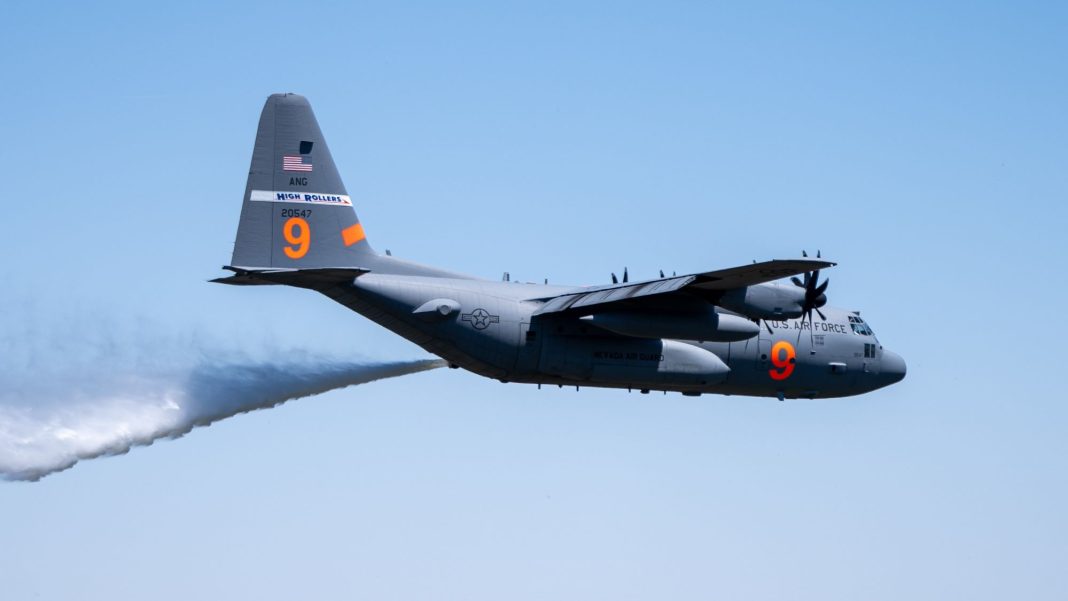The Modular Aerial Fire Fighting Systems program was instituted in 1971 as a collaboration between the U.S. Forest Service and the Department of Defense. The MAFFS system can be installed inside C-130 airplanes without any structural modification in just two hours.
The U.S. Northern Command activated eight of its C-130 aircraft equipped with MAFFS (Modular Aerial Fire Fighting Systems) on Jan. 10, 2025 to help fight the raging fires in the Los Angeles area, and some of the aircraft are already at work. All the aircraft are expected to be operational over the disaster zone by Jan. 12, NORTHCOM said. Personnel would relocate from their home bases to the Channel Islands in Southern California.
The 146th Airlift Wing (146th AW) from the California Air National Guard (ANG), the 152nd AW Airlift Wing and 192nd Airlift Squadron (192nd AS) from Reno, Nevada, the 153rd AW and 187th AS from Cheyenne, Wyoming, and the 302nd AW and 731st AS from Peterson Space Force Base, Colorado, are sending their MAFFS-equipped aircraft to Port Hueneme, where they will be hosted by the 146th AW. Videos showed one of the aircraft from the California Air Guard dropping the red-colored retardant liquid while withstanding a significant crosswind.
🟥 CAAG US Air Force MAFF C130’s struggling with winds today. #PalisadesFire pic.twitter.com/Dos5NMi09J
— INTERCEPT⭕R ᴼˢᴵᴺᵀ/ ᴹᵃʳᵏᵉᵗˢ (@InterceptorNews) January 9, 2025
Interestingly, just short of a year ago, the 146th AW and the 152nd AW participated in their annual refresher MAFFS training courses at Port Hueneme and Green Valley, California, in April and May 2024. The latest pictures on DVIDS show Airmen from the 152nd Maintenance and Logistics Readiness Squadron at the Nevada ANG base load a MAFFS system onto a C-130 of the 152nd AW “High Rollers.” One of the pictures showed crewmen preparing to attach a MAFFS nozzle onto the aircraft.
USNORTHCOM has activated 8x C-130 aircraft equipped with MAFFS to relocate to the Channel Islands in Southern California to support firefighting efforts in the LA area. Some will be operational on Jan. 10, with all ready by Jan. 12. See link for more:https://t.co/3C16xF2VMz pic.twitter.com/rqTmlNOYEm
— U.S. Northern Command (@USNorthernCmd) January 10, 2025
Devastating fires and vaunted additional capability
At the time of filing this report, the raging fires killed ten people and destroyed over 9,000 structures, as per the LA Times. Earlier, the Palisades Fire department said on Facebook that an aerial survey on Jan. 8 estimated approximately 5,316 residential and commercial structures destroyed. The survey employed infrared technology to gather the data.
The pressing in of additional aerial firefighting systems also comes amid one of the two Canadair CL-415 Super Scooper water-dropping aircraft, deployed by Canada, rendered temporarily inoperable after a collision with a drone on Jan. 9. The War Zone reported that the UAV was flown by an individual recording the firefighting efforts while violating a TFR (Temporary Flight Restriction) imposed by the FAA (Federal Aviation Administration), in effect from Jan. 9 to Jan. 23.
CL-415 SuperScoopers
filling up seawater off the coast of Los Angeles pic.twitter.com/HnZb3aPGZP— das Framke 🇺🇸 (@Futureview) January 10, 2025
In the impact, the UAV was able to punch a hole in the left wing’s leading edge. The CL-415 was able to land safely but had to be grounded for repairs before being considered again airworthy. Two more CL-415s are now on their way to California.
Track of the plane that got hit, registration C-GQBE. Unknown when it was hit, but very likely was one of the last passes as I can’t imagine them doing more passes after a drone collision like that. Likely happened around 14:30L
QUE245 #C06F07 C-GQBE https://t.co/wHTnqZVY23 pic.twitter.com/8P4a7tDsWn
— TieDye Intel (@TieDyeIntel) January 10, 2025
NORTHCOM has designated March Air Reserve Base at Riverside County in California as the Federal Emergency Management Agency (FEMA) Incident Support Base, providing the “forward distribution of supplies and equipment.” The press statement added that, “if requested, U.S. Northern Command is prepared to provide rotary wing support, ground and air search and rescue, commodity distribution, emergency route clearance, incident awareness and assessment, and medical capabilities.”
MAFFS-equipped C-130
MAFFS was instituted in 1971 as a collaborative effort between the U.S. Forest Service and the Department of Defense to “produce the equipment, training, and operational procedures to integrate military air tankers into a national firefighting response,” NORTHCOM said. The U.S. Air Force explains that the MAFFS unit that can fit inside C-130 airplanes is installed without any structural modification and within two hours.
The MAFFS equipment has a jet blower-type nozzle on the rear left-side near the bay doors. The carriage unit consists of a cylindrical tank, pumps and other electronic control and operation units that are loaded by Air Force Loadmasters through the rear ramp.
🎥: @ hollywoodguard
・・・
California Air National Guard personnel with the 146th Airlift Wing retrofit a C-130J Super Hercules aircraft with the MAFFS (Modular Airborne Fire Fighting System) at the Channel Islands Air National Guard Station, Port Hueneme, California, Jan. 8,… pic.twitter.com/QQe9koe6oi— Combat Learjet (@Combat_learjet) January 9, 2025
The system can discharge a fire retardant load of 3,000 gallons (11,356 liters/28,000 pounds) in less than five seconds through a discharge tube located in place of the left rear paratroop door of the aircraft. Released from an altitude of about 150 feet, the retardant covers an area one-quarter of a mile long and 60 feet wide, with the plane returning to an air tanker base to be refilled and again airborne in less than 20 minutes.
Interestingly, this is the very capability that CL-415 Super Scooper seaplanes offer by landing on a large water body to refill their tanks with 7,000 litres (1,850 US gallons) of water in just 14 seconds and quickly return to attack the fire. Other fixed-wing aircraft cannot execute continuous drops like the CL-415 and thus need to land back at an airport to refill.
C-130 MAFFS demo – pic.twitter.com/hm4BkVvBPp
— Scott Lowe (@tropicostation) March 20, 2023
The California Department of Forestry and Fire Protection (CALFIRE) also provided more details about how MAFFS will be employed. “Unlike CAL FIRE air tankers, MAFFS aircraft are not Initial Attack (IA) qualified, and require an Aerial Supervision Module/Lead Plane in order to conduct drops,” says the agency. “This typically limits their use to established, extended attack incidents, which help keep CAL FIRE and other IA air tankers available to be quickly dispatched to new fires.”
MAFFS units’ retardant is made up of 80 to 85% water, 10-15% ammonium sulfate, a gelling agent and red coloring. The red in the retardant acts as a ‘color code’, helping pilots see where they have dropped previous loads. The retardant itself disperses as a mist, preventing damage to buildings. The MAFFS crews participate in recurring annual training, with each unit required to have five certified personnel for the role.

MAFFS operations and history
The 146th AW, during an annual certification and training event at the California ANG in Port Hueneme on Apr. 26, 2024, displayed Air Force crews, USFS personnel and the Bureau of Land Management participating in classroom sessions, flying and ground operations. At least five C-130Js could be seen in the pictures.
The USFS supplies the MAFFS equipment and retardant, while the DoD provides the C-130J and C-130H aircraft. The Air Force also notes that USFS, Department of Agriculture or the state Governor only notify the DoD to activate MAFFS units after “exhausting private contractor assets.” This way, the service is able to provide “emergency capability to supplement existing commercial tanker support on wildland fires.”
Congress established the MAFFS following a major fire at Long Beach, California, that destroyed hundreds of homes and overwhelmed the civilian tanker fleet. The Forest Service says there are always a total of eight MAFFS ready for operational use.
One recent employment of MAFFS came in 2021, when the 152nd AW operated for 89 days in the second busiest MAFFS activation in 49 years, flying a total of 330 sorties and dropping 8.18 million pounds (912,042 gallons) of retardant. In the past decade, MAFFS-equipped military C-130s dropped about eight million gallons of fire retardant on wildfires in the U.S.
CA ANG C-130 MAFFS
9/29/23 pic.twitter.com/9PQEIs9iaC— Parker A. (@Parker_008) September 30, 2023




